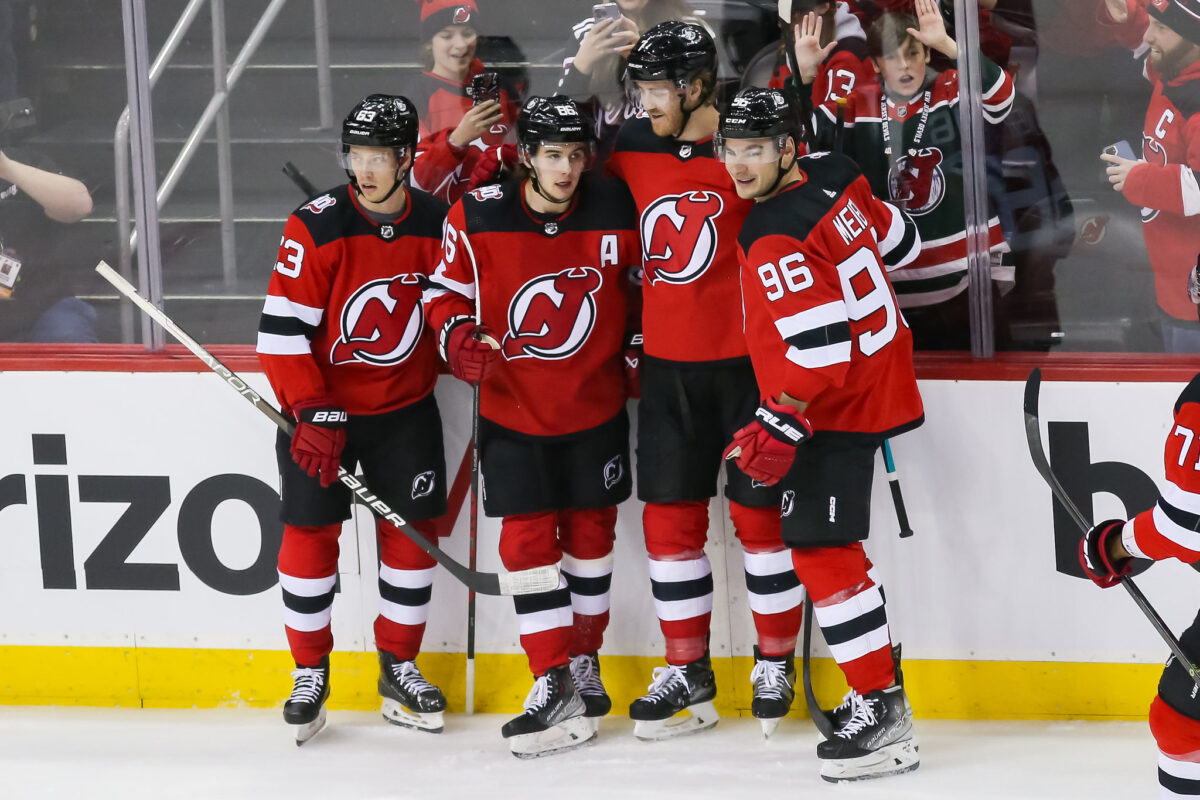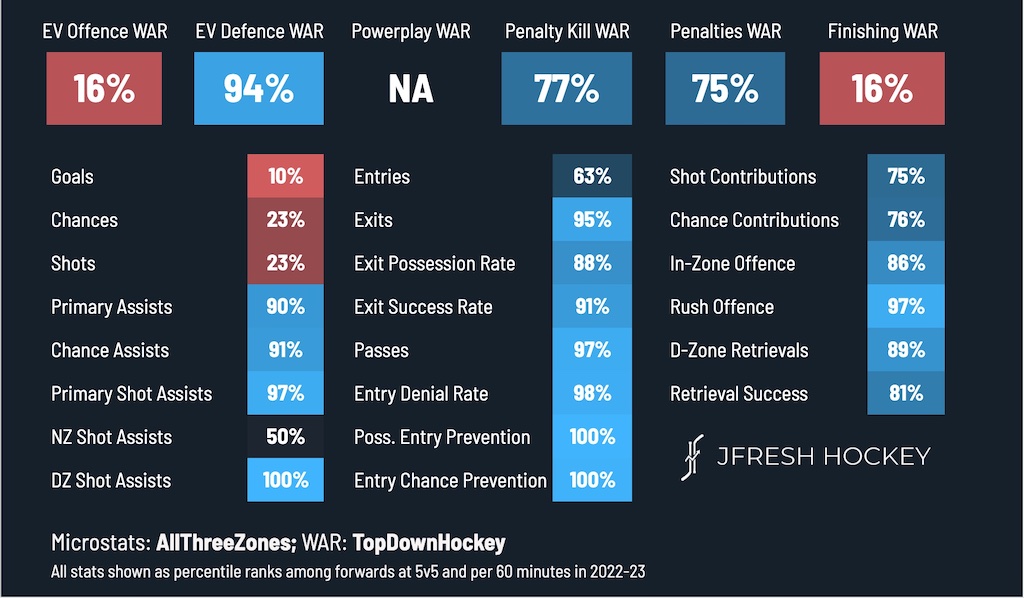The New Jersey Devils are in the playoffs for the first time since 2018, but their first-round opponent will be no easy task. The New York Rangers were one of the Eastern Conference’s top teams this regular season and have their sights set on representing the East in the Stanley Cup Final.
Likewise, the Devils are looking to prove that despite being one of the youngest teams in the league, they’re ready to compete among the best of the best in the Eastern Conference. What advantages do they have over the Rangers? What problems do the Rangers pose? Let’s get into it before Game 1 tomorrow night at the Prudential Center in Newark, New Jersey.
Devils Have the Edge at 5-on-5
Devils vs. Rangers: Last 25 Games Played at 5-on-5
| Stat | Devils | Rangers |
| Expected goals percentage (xG%) | 59.66 | 46.84 |
| Scoring chances for percentage (SCF%) | 60.64 | 47.16 |
| High-danger chances for percentage (HDCF%) | 62.83 | 46.65 |
| Scored-adjusted Fenwick percentage | 54.81 | 50.73 |
The Devils have the clear edge over the Rangers at five-on-five in this series, which could prove significant. Over their last 25 games, the Devils rank first in the NHL in xG%, SCF%, HDCF% and third in scored-adjusted Fenwick percentage. Scored-adjusted Fenwick has proven to be predictive of playoff success, so that bodes well for the Devils.
The Rangers, on the other hand, have struggled to control play at five-on-five. They rank 22nd, 21st, 21st, and 16th in the stats mentioned in the table above. Their issue isn’t necessarily on offense. It’s that they’ve given up some quality the other way. Their rate of 2.64 expected goals allowed per 60 minutes ranks 17th in the NHL, making them a middle-of-the-pack NHL team when it comes to allowing quality chances.

One reason the Rangers’ defense falls in the middle of the pack is they don’t defend the rush well. That could prove problematic against a Devils team that downhill skis against teams on the rush. Not only do they generate most of their offense that way, but they’re also quite effective at defending it. The Rangers are a decent rush team too, but they’ll have trouble against a Devils team that hasn’t allowed much of anything defensively for about two months.
Over their last 25 games, the Devils have allowed 2.35 expected goals per 60, ranked fifth in the NHL. Conversely, they’ve generated 3.48 expected goals per 60 on offense, the best mark in the NHL. Given the Rangers’ struggles defending the rush, the Devils shouldn’t have trouble generating offense at five-on-five. That happened to be the case in their four head-to-head matchups during the regular season, as the Devils posted a 59.6 xG% against the Rangers. The key is to get enough pucks past Igor Shesterkin, which is easier said than done.
Shesterkin vs. Devils Goaltending
Shesterkin hasn’t had another historic season as he did in 2021-22, but he’s still been one of the best goalies in the NHL. Sure, his save percentage has dropped from .934 to .916 this season, but that’s still well above the league average of .899. His underlying metrics have also been some of the best among NHL goalies this season. He’s stopped 27.84 goals above expected, placing him in the top five among NHL netminders, just ahead of Andrei Vasilevskiy. It’s not to the level he was a season ago, but that was a once-in-10-years type of effort.
The Devils have a challenge ahead of them, but the good news is they found success against Shesterkin this season; his SV% against them was .907. With that said, the playoffs are a different ball game. He made 20 starts in the Rangers’ run to the Eastern Conference Final a year ago, posting a .929 SV%. It likely won’t take much for him to get into a groove, so the Devils must find different ways to score than just off the rush.
One way to make life difficult for Shesterkin is by getting traffic in front of him. The Rangers ranked 27th in SV% on shots through traffic this season. Some of that is likely due to Jaroslav Halak, too, but it’s something the Devils should look to exploit. They can do so with Timo Meier, who they acquired in a trade from the San Jose Sharks ahead of the trade deadline. Look at the net-front traffic he provided in front of Vasilevskiy on this Jesper Bratt goal a few weeks ago (goal begins at 3:35 of highlights):
Not many goalies will stop a shot with that kind of traffic in front of them, even Vasilevskiy. Look for Meier to use his 6-foot-1, 220-pound frame to get to the net front to provide screens and perhaps cash in on goals from around the blue paint, where he makes a living.
As for Vitek Vanecek, he’s had a solid season with the Devils, his first in New Jersey. He finished with a .911 SV% and stopped 13.28 goals above expected, the latter of which ranked 14th in the NHL. He has struggled to save high-danger shots, but the Devils don’t give up many of those to begin with.
He only has three games of playoff experience, which came with the Washington Capitals over the previous two seasons. Could that be a factor? Time will tell, but the Devils need him to perform at a high level against the Rangers’ elite shooting talent to have a chance at winning the series.
Devils head coach Lindy Ruff also needs to figure out who backs up Vanecek. Based on their regular-season finale, it should be Akira Schmid, who posted 20 saves on 20 shots in relief of Mackenzie Blackwood in a 5-4 win over the Washington Capitals. Schmid finished the season with a .922 SV% and saved 8.47 goals above expected in 18 games, while Blackwood had a .893 SV% and stopped 0.44 goals above expected. Schmid has done well in a few relief appearances, so the answer seems clear.
Special Teams
The key matchup to watch on special teams will be the Rangers’ power play versus the Devils’ penalty kill. For the second season in a row, the Rangers’ power play ranked in the top 10 of the NHL, while the Devils’ penalty kill finished ranked fourth, killing off 82.61 percent of the man-advantage opportunities they faced.
The Devils’ penalty kill ranked in the top five because they were one of the best shot-suppressing units in the NHL. They gave up an average of 89.7 shot attempts per 60, ranked seventh, while only giving up 6.82 expected goals per 60, ranked sixth. Devils goalies stopped .875 percent of the shots they faced when the team was down a man, a middle-of-the-pack number.
Related: Devils Speed & Rush Offense Could Dominate Rangers
As for the Rangers, they were one of the best shot-generating teams on the power play. They ranked first in shot attempts per 60 and fourth in expected goals per 60. Their shooting percentage was in the bottom 10 of the league, so they probably should have scored more on the power play than they did during the regular season. That means it won’t take much for it to pop off during the playoffs.
When it comes to the Devils’ power play vs. the Rangers’ penalty kill, this is a bit less intriguing than the opposite matchup. The Devils’ power play was solid this season, finishing at 22.22 percent, ranked 13th in the NHL. Likewise, the Rangers had a solid penalty kill, with an 81.17 percent success rate, also ranked 13th in the NHL.
The Devils ranked in the top ten for expected goals per 60 on the power play, while the Rangers ranked seventh in expected goals against per 60 on the penalty kill. But this isn’t the matchup that likely determines who wins the special teams battle. It’ll be the Rangers’ power play versus the Devils’ penalty kill since both units are among the league’s best.
Key Player Matchups to Watch
Marino & Hischier vs. the Panarin Line
As in any playoff series, there are always player matchups to watch. Acquired from the Pittsburgh Penguins over the summer, John Marino has been the Devils’ best defensive defenseman this season. He’s logged the most difficult minutes among the team’s blueliners and has posted sparkling underlying metrics.
Marino has been great defensively because his ability to defend the rush is among the best for NHL blueliners. He ranks in the 100th percentile in possession entry prevention and entry chance prevention and is in the 98th percentile when it comes to denial rate:

Not only can Marino defend against the rush, but he’s an effective puck-mover who gets the rush going the other way. Because of those abilities, you’ll likely see Ruff hard-match Marino against the line of Artemi Panarin, Vincent Trocheck and Vladimir Tarasenko in the first two games of the series since the Devils have home-ice advantage and last change.
Joining Marino for those shifts will likely be Nico Hischier, who could be a Selke Trophy finalist for the best defensive forward this season. Not only has he excelled defensively, but Tomáš Tatar has also been one of the league’s best two-way wingers in 2022-23. Along with Dawson Mercer, this trio posted a 65.8 xG% in 267 minutes together in the regular season. Because they can control play with their high-end two-way ability, expect to see plenty of them against Panarin’s line in the first two games, with Marino on the back end.
Hughes vs. the Zibanejad Line
Offensively, Ruff should be looking to get Jack Hughes out against the line of Chris Kreider, Mika Zibanejad and Patrick Kane as often as possible. That line hasn’t played much together because Rangers head coach Gerard Gallant only put them together for the last few games of the regular season. But their defensive numbers, albeit in a small sample, indicate there may be something to exploit.
Though this iteration of the Zibanejad line has only been on the ice for one goal against, they’re giving up 2.88 expected goals per 60. Virtually nothing has found the back of the net against them because their on-ice SV% is .955. That’s an unsustainably high on-ice SV%, so it’s only a matter of time before goals against occur, given the rate at which they’re giving up quality.

That seems like an ideal matchup for Hughes and his linemates, Jesper Bratt and Ondrej Palát. Hughes and Bratt have posted strong five-on-five results together since the start of last season, and that’s continued this season with Palát, with the trio posting a 59.38 xG% in about 123 minutes together. That gives the Devils a formidable 1-2 punch in their top six with the way the Hischier line has played.
Hughes and Bratt match up well against the Zibanejad line because Kane is a defensive liability. That’s been an issue with him for years, and it’s continued since the Rangers acquired him from the Chicago Blackhawks ahead of the trade deadline. His rate of 3.12 expected goals against per 60 is the worst among all Rangers skaters this season, so Ruff should be looking to deploy his best player in Hughes against Kane to generate offense.
Predictions: Do the Devils Advance to Round 2?
Let’s start with the advantages the Devils have over the Rangers. They’re clearly the better five-on-five team. Even when you expand the stats from the last 25 games played to the entire regular season, the Devils have a significant edge at that game state. The Rangers may be a heavier and more physical team, but the Devils will likely find ways to control the game at five-on-five through their speed as they did in their four regular-season head-to-head contests.
As for the Rangers, they have an advantage on the power play, though the Devils’ top-five penalty kill may be able to negate that. Where they have a clear edge is in net with Shesterkin. He was fantastic a season ago in the Rangers’ run to the Eastern Conference Final, so it’d be foolish to think he can’t put up a repeat performance this year.
This series is close to a toss-up for me. The Devils are a much better five-on-five team, but Shesterkin is an eraser and will make this a series. The Devils may be the less experienced team, but the Rangers were in the same position a year ago, and how’d that go for them? New York also has high-end finishing talent, so they will find ways to score in some games. I’m picking the Devils to win in seven, but it’s essentially a coin flip. Either way, it should be an exciting series that adds another chapter to this storied local rivalry.
* * *
Advanced stats from Natural Stat Trick, Evolving-Hockey; microstats from Corey Sznajder via JFresh Hockey